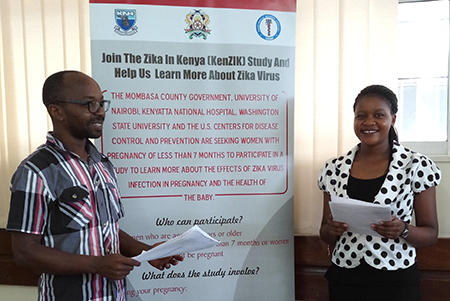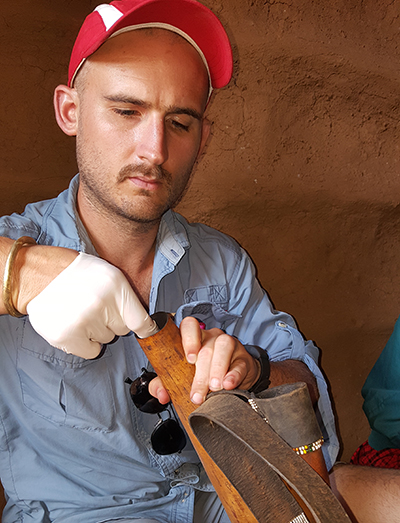By Marcia Hill Gossard, College of Veterinary Medicine
When people have adequate sanitation and clean water, and the animals they raise for food are free from disease, those people not only are healthier, but they have improved opportunities in life through higher income, better education and overall well-being. That is One Health.
For the last 10 years, the Paul G. Allen School for Global Animal Health has been committed to doing just that by helping to create healthier communities. Here is a quick snapshot of a few life-changing advancements that scientists with WSU have helped to bring to areas like Tanzania and Kenya.
Our scientists have seen that by vaccinating cattle for East Coast Fever, a young girl in rural Africa can attend school because her family has milk to sell from a healthy cow, which leaves an intergenerational impact on the community. Or an entire family is spared hunger and economic hardship because vaccinations for Newcastle disease prevent the decimation of a community’s chickens.
Improved health practices including the pasteurization of milk, prevents bacterial infections such as E. coli, Salmonella or Campylobacter and reduces the number of illnesses that ultimately would need to be treated with antibiotics. By discovering the causes for increases in antibiotic use, our scientists have helped implement ways to reduce infection and the spread of resistant bacteria in poor communities worldwide, which not only protects those communities but helps preserve effective antibiotics here around the world and here at home.
Healthy Children
At the Coast General Hospital in Mombasa, Kenya, pregnant women sit in the waiting room to see a doctor for a monthly prenatal wellness check. Allen School medical epidemiologist Dr. Eric Osoro also waits to ask the women if they would agree to participate in a study to test for the Zika virus.

Transmitted by the Aedes aegypti mosquito, the Zika virus causes microcephaly, a birth defect in children where the head is smaller than other children of the same age. In Kenya, Aedes aegypti mosquitoes are prevalent in coastal regions and spread dengue fever, a disease that is related to the Zika virus.
Once they agree to participate, the women fill out a questionnaire and give a blood sample to test for the virus. Osoro and his team will do monthly follow ups with the women. “After the baby is born we will follow up with the infants to assess for growth and neurodevelopment,” says Osoro.
What the researchers learn will not only be used to help prevent Zika in Kenya, but also assist health workers to counsel patients about the risks of the virus and provide health care facilities with information to offer the most effective services to children with microcephaly.
Healthy families
A Maasai woman in northern Tanzania collects cow’s milk for her family in a gourd called a calabash. Milk is a staple in the diet of the Maasai and can make up about half of their daily calories. After finding antibiotic resistant E. coli bacteria in their milk, anthropologist Mark Caudell teamed with students in the WSU Center of Entrepreneurial Studies to develop a basic thermometer that could be placed in a pot of milk over a fire. When the milk is hot enough to kill any bacteria, the end of the thermometer lights up green. Before the thermometers, it was impossible for the Maasai women to know how hot they needed to warm the milk to kill bacteria.

“We found that mothers trained to pasteurize their milk using our thermometers heat-treated milk more often and drank milk with less bacteria,” says Caudell. “We are now working with engineers at WSU on a redesign that will allow multiyear use.”
Caudell and his team plan to return to Tanzania this summer and find the most effective ways to distribute the thermometers in these hard-to-reach, rural communities. “We want to empower Maasai women within these communities to teach other community members about the importance of milk hygiene and pasteurization,” says Caudell.
Watch the video about Caudell’s work at go.vetmed.wsu.edu/CaudellThermometer.
Healthy Communities
As Kenya’s climate has become drier with more frequent droughts, raising camels is increasingly common for pastoral households that traditionally may have only kept cattle or goats as livestock. Dr. Kariuki Njenga, a virologist with the Allen School, and his team are researching brucellosis, an infectious disease caused by the bacteria Brucella. Brucellosis affects many animal species, but because of a camel’s lifespan, they can harbor and spread the disease for years.
“While a family may expect to have a cow for about four years, and a goat for about two years, camels can live 25 years or more,” says Njenga. “That means camels could infect three generations of cows.”
Brucellosis is a bacterial zoonotic infection that is often transmitted to humans from unpasteurized milk. While rarely fatal, the disease can have long-term effects such as recurrent fevers, arthritis, swelling of the heart, and chronic fatigue. Animals infected with the disease produce less milk, abort, can become infertile, and are a risk to other animals in the herd.

Although specific bacteria species generally infect cattle, sheep, goats, or camels, some Brucella species can cross animal species. And there is very little information on the Brucella species in camels. So back in Pullman, Dr. Tim Baszler and a team of scientists in the Washington Animal Disease Diagnostic Laboratory are working with the WSU team in Kenya using genetic analysis to identify different species of Brucella to determine the dominant strains of the bacteria. This will help Allen School scientists better understand how the bacteria transmits from animals to humans, and to develop ways to control the spread of the bacteria.
Because antibiotics are the treatment for brucellosis, knowing how to best prevent the spread of the disease will reduce antibiotic use and decrease the risk of developing new strains of resistant bacteria that can spread globally.
See this article at the College of Veterinary Medicine website.
Contact:
- Marcia Hill Gossard, senior writer, College of Veterinary Medicine, 509-335-8242, mgossard@wsu.edu






